L07-静态句与动作句的互变与区别 初中英语词性句法新讲课件
文档属性
| 名称 | L07-静态句与动作句的互变与区别 初中英语词性句法新讲课件 | 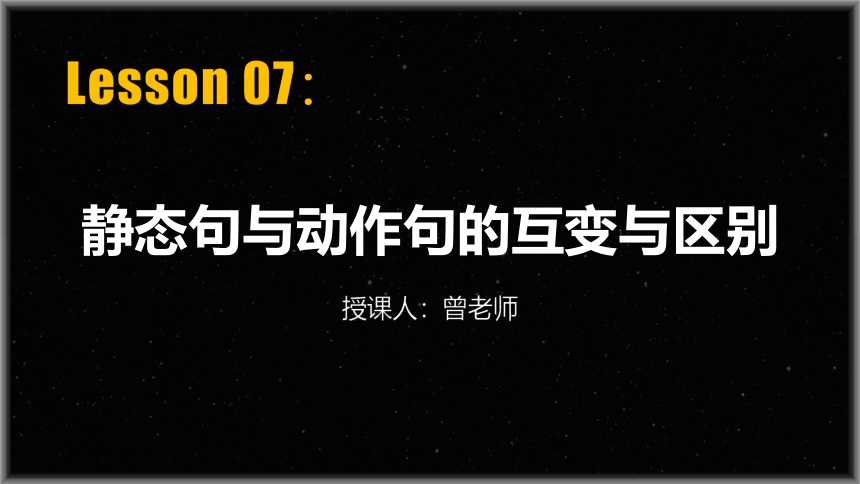 | |
| 格式 | ppt | ||
| 文件大小 | 1.1MB | ||
| 资源类型 | 试卷 | ||
| 版本资源 | 通用版 | ||
| 科目 | 英语 | ||
| 更新时间 | 2022-04-09 19:16:21 | ||
图片预览

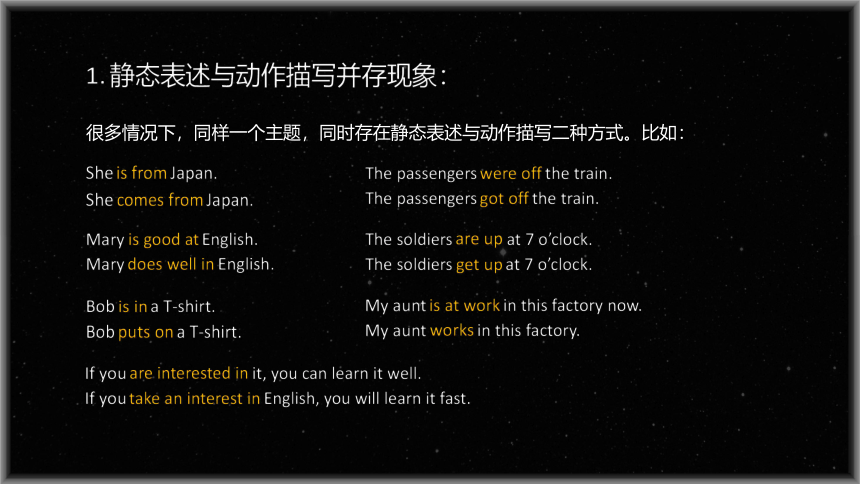
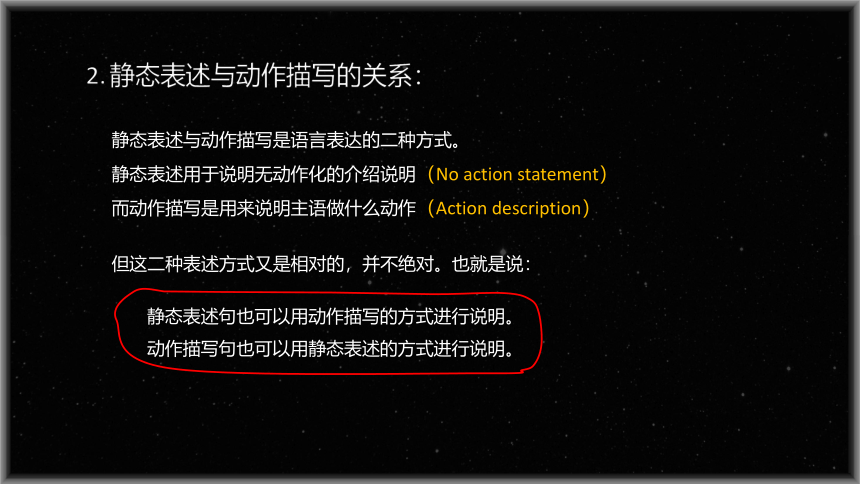
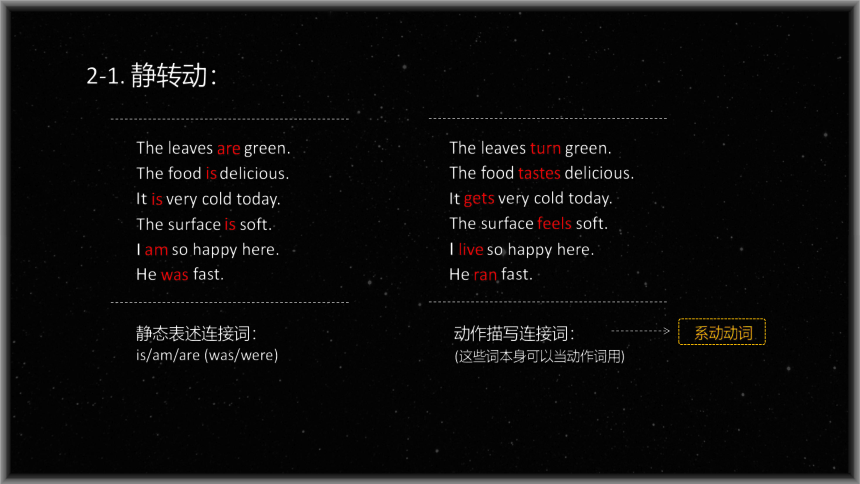
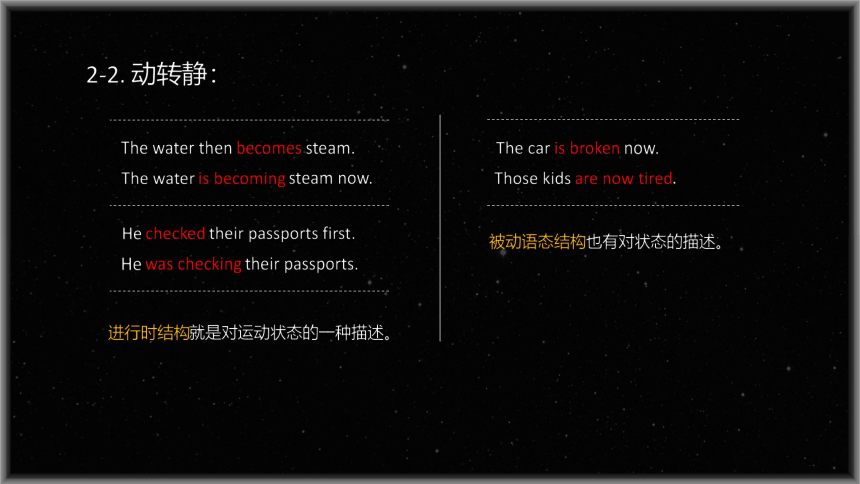
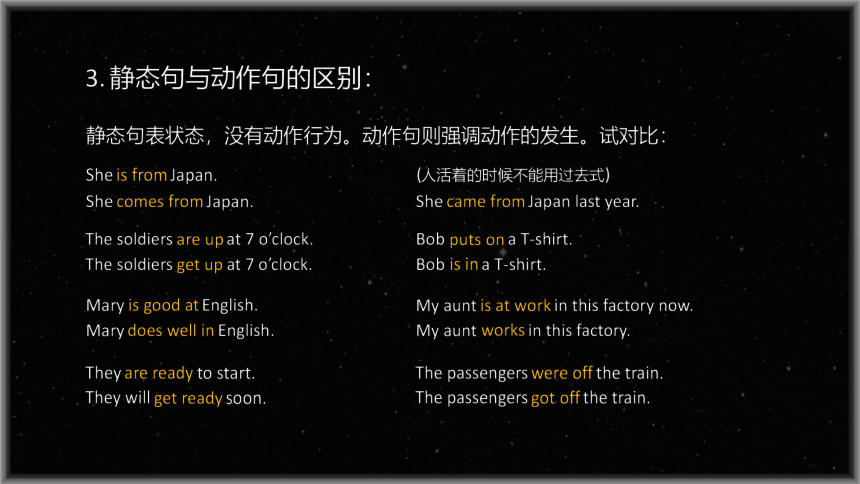
文档简介
(共12张PPT)
静态句与动作句的互变与区别
Lesson 07:
授课人:曾老师
1. 静态表述与动作描写并存现象:
很多情况下,同样一个主题,同时存在静态表述与动作描写二种方式。比如:
The passengers were off the train.
The passengers got off the train.
If you are interested in it, you can learn it well.
If you take an interest in English, you will learn it fast.
She is from Japan.
She comes from Japan.
My aunt is at work in this factory now.
My aunt works in this factory.
The soldiers are up at 7 o’clock.
The soldiers get up at 7 o’clock.
Mary is good at English.
Mary does well in English.
Bob is in a T-shirt.
Bob puts on a T-shirt.
静态表述与动作描写是语言表达的二种方式。
静态表述用于说明无动作化的介绍说明(No action statement)
而动作描写是用来说明主语做什么动作(Action description)
静态表述句也可以用动作描写的方式进行说明。
动作描写句也可以用静态表述的方式进行说明。
2. 静态表述与动作描写的关系:
但这二种表述方式又是相对的,并不绝对。也就是说:
The leaves are green.
The leaves turn green.
The food is delicious.
The food tastes delicious.
It is very cold today.
It gets very cold today.
The surface is soft.
The surface feels soft.
I am so happy here.
I live so happy here.
He was fast.
He ran fast.
静态表述连接词:
is/am/are (was/were)
动作描写连接词:
(这些词本身可以当动作词用)
系动动词
2-1. 静转动:
He checked their passports first.
He was checking their passports.
The water then becomes steam.
The water is becoming steam now.
进行时结构就是对运动状态的一种描述。
2-2. 动转静:
The car is broken now.
被动语态结构也有对状态的描述。
Those kids are now tired.
3. 静态句与动作句的区别:
静态句表状态,没有动作行为。动作句则强调动作的发生。试对比:
She is from Japan.
She comes from Japan.
My aunt is at work in this factory now.
My aunt works in this factory.
The soldiers are up at 7 o’clock.
The soldiers get up at 7 o’clock.
Bob puts on a T-shirt.
Bob is in a T-shirt.
(人活着的时候不能用过去式)
She came from Japan last year.
Mary is good at English.
Mary does well in English.
They are ready to start.
They will get ready soon.
The passengers were off the train.
The passengers got off the train.
3. 静态句与动作句的区别:
When I go out of the house, ...
When I am out of the house, ...
If you are interested in it, you can learn it well.
If you take an interest in English, you will learn it fast.
Is it snowy in England in December
Does it snow in England in December
3. 静态句与动作句的区别:
在翻译或表述的过程中,特别要注意中英文在表述方式上的区别。
分清楚到底是静态表述,还是动作描写。
4. 静态句与动作句表述练习:
练习2:别动,你把我搞痛了。
Stop! You make(get) me hurt.
练习3:明天下午三点我去火车站接你。
I will be waiting for you at 3 o’clock tomorrow afternoon.
I will go to pick you up at 3 o’clock tomorrow afternoon.
练习1:我老板他刚离开这里。
My boss left away from here.
My boss is now away from here.
Stop! You are hurting me.
4. 静态句与动作句表述练习:
练习4:当你出门在外的时候,应该要戴上口罩。
You should wear a mask when you go out.
You should be wearing a mask when you are out.
练习5:小孩子们在学步时经常会摔跤跌倒。
Babies often fall down when they learn to walk.
Babies often fall down when they are learning to walk.
练习6:路过我家时,请进来坐坐。
Please drop in when you pass my way.
Please drop in when you are passing my way.
4. 静态句与动作句表述练习:
练习7:我们正在教室里谈话,老师走了进来。
We were talking in the classroom when the teacher came in.
练习8:当我一个人在街上骑车时,突然,一辆小车撞倒了我。
When I was riding alone in the street, all of sudden, a car knocked me down.
练习9:我刚要出门,这时门铃响了。
The bell rang when I was just about to leave.
4. 静态句与动作句表述练习:
所以,“be doing”不一定要全部理解为“正在进行”。
它还有说明动作“正处于...状态中”的意思。
练习10:你在这边一直要呆到下周五吗?
Are you staying here till next Friday
练习11:牛奶的沸点比水高。
Milk is boiling at a higher temperature than water.
静态句与动作句的互变与区别
Lesson 07:
授课人:曾老师
1. 静态表述与动作描写并存现象:
很多情况下,同样一个主题,同时存在静态表述与动作描写二种方式。比如:
The passengers were off the train.
The passengers got off the train.
If you are interested in it, you can learn it well.
If you take an interest in English, you will learn it fast.
She is from Japan.
She comes from Japan.
My aunt is at work in this factory now.
My aunt works in this factory.
The soldiers are up at 7 o’clock.
The soldiers get up at 7 o’clock.
Mary is good at English.
Mary does well in English.
Bob is in a T-shirt.
Bob puts on a T-shirt.
静态表述与动作描写是语言表达的二种方式。
静态表述用于说明无动作化的介绍说明(No action statement)
而动作描写是用来说明主语做什么动作(Action description)
静态表述句也可以用动作描写的方式进行说明。
动作描写句也可以用静态表述的方式进行说明。
2. 静态表述与动作描写的关系:
但这二种表述方式又是相对的,并不绝对。也就是说:
The leaves are green.
The leaves turn green.
The food is delicious.
The food tastes delicious.
It is very cold today.
It gets very cold today.
The surface is soft.
The surface feels soft.
I am so happy here.
I live so happy here.
He was fast.
He ran fast.
静态表述连接词:
is/am/are (was/were)
动作描写连接词:
(这些词本身可以当动作词用)
系动动词
2-1. 静转动:
He checked their passports first.
He was checking their passports.
The water then becomes steam.
The water is becoming steam now.
进行时结构就是对运动状态的一种描述。
2-2. 动转静:
The car is broken now.
被动语态结构也有对状态的描述。
Those kids are now tired.
3. 静态句与动作句的区别:
静态句表状态,没有动作行为。动作句则强调动作的发生。试对比:
She is from Japan.
She comes from Japan.
My aunt is at work in this factory now.
My aunt works in this factory.
The soldiers are up at 7 o’clock.
The soldiers get up at 7 o’clock.
Bob puts on a T-shirt.
Bob is in a T-shirt.
(人活着的时候不能用过去式)
She came from Japan last year.
Mary is good at English.
Mary does well in English.
They are ready to start.
They will get ready soon.
The passengers were off the train.
The passengers got off the train.
3. 静态句与动作句的区别:
When I go out of the house, ...
When I am out of the house, ...
If you are interested in it, you can learn it well.
If you take an interest in English, you will learn it fast.
Is it snowy in England in December
Does it snow in England in December
3. 静态句与动作句的区别:
在翻译或表述的过程中,特别要注意中英文在表述方式上的区别。
分清楚到底是静态表述,还是动作描写。
4. 静态句与动作句表述练习:
练习2:别动,你把我搞痛了。
Stop! You make(get) me hurt.
练习3:明天下午三点我去火车站接你。
I will be waiting for you at 3 o’clock tomorrow afternoon.
I will go to pick you up at 3 o’clock tomorrow afternoon.
练习1:我老板他刚离开这里。
My boss left away from here.
My boss is now away from here.
Stop! You are hurting me.
4. 静态句与动作句表述练习:
练习4:当你出门在外的时候,应该要戴上口罩。
You should wear a mask when you go out.
You should be wearing a mask when you are out.
练习5:小孩子们在学步时经常会摔跤跌倒。
Babies often fall down when they learn to walk.
Babies often fall down when they are learning to walk.
练习6:路过我家时,请进来坐坐。
Please drop in when you pass my way.
Please drop in when you are passing my way.
4. 静态句与动作句表述练习:
练习7:我们正在教室里谈话,老师走了进来。
We were talking in the classroom when the teacher came in.
练习8:当我一个人在街上骑车时,突然,一辆小车撞倒了我。
When I was riding alone in the street, all of sudden, a car knocked me down.
练习9:我刚要出门,这时门铃响了。
The bell rang when I was just about to leave.
4. 静态句与动作句表述练习:
所以,“be doing”不一定要全部理解为“正在进行”。
它还有说明动作“正处于...状态中”的意思。
练习10:你在这边一直要呆到下周五吗?
Are you staying here till next Friday
练习11:牛奶的沸点比水高。
Milk is boiling at a higher temperature than water.
同课章节目录
- 词法
- 名词
- 动词和动词短语
- 动词语态
- 动词时态
- 助动词和情态动词
- 非谓语动词
- 冠词
- 代词
- 数词和量词
- 形容词副词及其比较等级
- 介词和介词短语
- 连词和感叹词
- 构词法
- 相似、相近词比较
- 句法
- 陈述句
- 一般疑问句和否定疑问句
- 特殊疑问句及选择疑问句
- 反意疑问句
- 存在句(There be句型)
- 宾语从句
- 定语从句
- 状语从句
- 主谓一致问题
- 简单句
- 并列句
- 复合句
- 主谓一致
- 主、表语从句
- 名词性从句
- 直接引语和间接引语
- 虚拟语气
- 感叹句
- 强调句
- 倒装句
- 祈使句
- 句子的成分
- 句子的分类
- 题型专区
- 单项选择部分
- 易错题
- 完形填空
- 阅读理解
- 词汇练习
- 听说训练
- 句型转换
- 补全对话
- 短文改错
- 翻译
- 书面表达
- 任务型阅读
- 语法填空
- 其他资料
